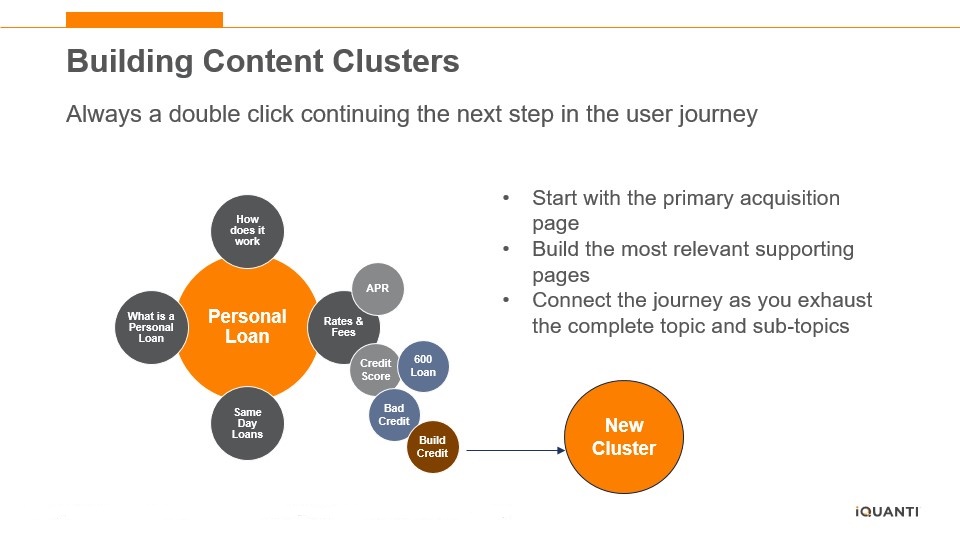SEO
A 4-Step Guide To Improving SEO With Powerful Topic Clusters

This post was sponsored by iQuanti. The opinions expressed in this article are the sponsor’s own.
What transforms a website from just a catalog of blog posts to a highly-organized hub of authoritative content?
How can you make sure your website becomes the top-visited resource for your industry?
Today, we’re going to travel down the content rabbit hole, and peer through the SEO looking glass, if you will.
You’ll discover how to easily merge content creation and SEO to help your website successfully rank at the top of search engine results pages (SERPs) using topic clusters.
Your goal: Create content that is able to answer your target audience’s questions by providing everything they need to know about their search queries.
The classic Alice in Wonderland series posed a quasi-metaphorical question to its protagonist: “Why is a raven like a writing desk?”
The question posited has nothing to do with the plot, leaves nothing to inform the characters’ growth or intentions, and may very well be construed as pure nonsense, a symptom of fantasy.
At the end of the story, Alice asks The Hatter, “Why is a raven like a writing desk?”
Though no answer was provided – and many answers have been theorized since – readers not only embrace this fantastical reality but champion it as part of the inherent logic of the narrative.
We’ve come to Wonderland to believe in the absurd possibilities of this reality, however nonsensical they may appear.
When it comes to your SEO strategy, you won’t be delving into fictional worlds or constructing outlandish characters and situations. You will, however, be in command of your narrative and its inherent logic.
You will need to:
- Understand what your audience is looking for or trying to understand, lest you lose out on active users’ time on your page – a critical metric in search engine algorithms.
- Know how your content is interconnected, how to prioritize it, and how to measure its impact.
- Remember why it’s essential to keep your customer following the narrative down the content rabbit hole.
Step 1: Understand & Track Search Intent
Your audience’s search history and webpage behavior can speak volumes about their search intent and needs, even if it’s impossible to actually know what’s going on in a person’s mind.
SEO’s analytical aspects can uncover search intent based on keyword queries.
If you pair SEO analytics with subject-matter experts (SMEs), you can also supercharge your strategy by plotting topical interests and predicting a person’s position within your marketing funnel.
How To Discover Search Intent To Build Successful Topic Clusters
You and your SMEs can easily develop one or more themed keyword landscapes, or “topic clusters”, by simply researching the root of a regular person’s keyword queries:
- Define query intent across your customer journey. Are your customers more likely to use search terms that signal awareness, consideration, comparison, or purchase intent in different parts of your sales and marketing funnel?
- Audit your existing keyword footprint, your competitive footprint, and your pay-per-click (PPC) performance.
- Explore and document new keyword opportunities that logically arise from your audit.
- Compile a master keyword list.
Your master keyword list will help you and your team clearly understand how your points of entry can be better positioned or supported on a user’s journey through your sales funnel.
Step 2: Create A Master Keyword List To Uncover Keyword Gaps & Cluster Foundations
You’ll want to walk away from step one with a master keyword list that will help you discover the content gaps that can be used to bridge your past content efforts with your present or future ones.
This helps you quickly see if your target audience’s search intent matches your website’s page intent.
Why A Master Keyword List Works
Master keyword lists work because they help make sure you’re covering every need of your target audience.
Once you’ve completed your master keyword list, look at how complete and logical your list of targeted keywords truly is.
Ask yourself if a reader finds your website after a query:
- Will they need to take a step back to figure out how believable or valid the information you’re presenting them is?
- Will the provided backlinks on that page assume that this user knows all they need to know, while attempting to redirect them to a product page without informing them of how you perform better than your competitors?
Either of these paths can quickly become disjointed without a logical flow of information.
That’s where the last high-level takeaway from your master keyword list can be beneficial: spinning a web of core, supporting, and related themes to ensnare and enthrall your user.
This is what creates the foundation of topic clusters.
 Image created by iQuanti, January 2023
Image created by iQuanti, January 2023Step 3: Create Content & Topic Clusters
As you’ve seen, search intent needs to translate to page intent.
So, careful consideration during the keyword selection phase is key for content creation because of the many themes and subthemes that your brand, products, and services may cover.
These subthemes are the pillars of your topic cluster strategy. Implementing content clusters is an effective means of covering full topics in organized, digestible bites.
 Image created by iQuanti, January 2023
Image created by iQuanti, January 2023How To Create Content Clusters
Once your audience stumbles upon your landing page, the content must be compelling enough to draw their attention further.
Engage perceptions with stats and diagrams, provide visuals and lists, condense information, and challenge inquisitive minds to learn more on the next page.
Here’s how:
- Select your highest priority acquisition – conversion – pages and exhaust the themes and subthemes relating to it by building relevant awareness and consideration articles around it.
- Identify and connect the journey to different topics and subthemes with backlinks. For example, let’s say you’re building a product page for personal loans. You will naturally need to mention loan rates and credit scores to substantiate your offering.
- Create spinoff content. For example, can this spin off into article pages for “What’s a Good Credit Score?” and “How to Qualify for Affordable Loan Rates”? You could even compile information about the loan rates you offer for each credit score tier, compare your loan rates to your competitors, provide tips for improving your credit score, and so many more themes within themes.
- Enhance your content with videos, infographics, or sound bites.
As readers spin through your website, they become familiar with your brand, style, and voice, and might even develop some level of trust from their visit – if you’ve provided the information they’re looking for.
Step 4: Review Content Marketing Metrics & Analytics
Tracking where your readers explore your site more thoroughly will only further the plot – keeping in mind general consumer demand and some KPIs.
Whether it’s the value added by a narrative or a more consistent website flow, pages can be identified for their:
- Conversion rate (CVR).
- Page views.
- Impressions.
- Time on page.
- And many other relevancy qualifiers concerning their intent.
After identifying successes, you can mimic these pages, which then can be integrated into your audience’s journey.
If metrics stagnate for some pages, they might need a refresh. Exploring different keyword landscapes and bridging cluster gaps can help improve your site’s authority and user experience (UX) overall.
In the worst-case scenario – after you’ve decided it’s no longer relevant to your site visitors or from a keyword volume standpoint – you can decommission and 301 redirect any content that no longer performs in a way that fulfills your brand’s purposes.
 Image created by iQuanti, January 2023
Image created by iQuanti, January 2023Ensuring your site structure ranks well compared to competitors or industry aggregators can be challenging without sophisticated technological support – and there’s only so much that can be done unless you want to overhaul your website.
However, catching and nesting a customer to a purchase decision should involve an intuitive flow that won’t require the customer to encounter navigational mishaps, such as having to back out of pages.
Create A Topic Cluster-Driven World Of Your Own
At the beginning of her journey, freshly lost and before the conversation about a raven and a writing desk, Alice asks the Cheshire Cat, “Would you tell me, please, which way I ought to go from here?”
The Cat replies, “That depends a good deal on where you want to get to.”
Though we’ve all been Alice before – on a website, in a crowd, within a metaphor – you should be fostering the journey with the same absurd seriousness the Cheshire Cat proposes.
In the story, Alice must find herself before knowing what she wants to do.
Your customers may stumble upon you with questions, curiosities, and intent – are you positioning your content in a relatable way?
iQuanti uses the combination of their proprietary tech and trained UX strategists to:
- Identify and close gap deficiencies.
- Track algorithmic score changes.
- Improve site performance from a page level upwards.
If you believe you could use some help identifying content gaps or want to help drive the needle forward for your business, iQuanti’s SEO services could be just what you need.



















You must be logged in to post a comment Login